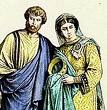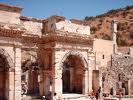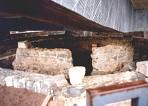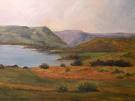| Next | Previous | Index | Tellout Home |
35. House Church Building
Early Christian Club
 The Apostle's assemblies physical setting, including the "Lord's Supper," can easily be visualized. Unlike the Jewish synagogue associations, as at Capernaum, Christians possessed no church buildings at all initially. While it was not impossible that, like the clubs, some early Christian congregations had property, they did not appear to set aside a house church building exclusively for worship until the late second century.✞
The Apostle's assemblies physical setting, including the "Lord's Supper," can easily be visualized. Unlike the Jewish synagogue associations, as at Capernaum, Christians possessed no church buildings at all initially. While it was not impossible that, like the clubs, some early Christian congregations had property, they did not appear to set aside a house church building exclusively for worship until the late second century.✞
Home or Rented Hall
 Christians sometimes rented buildings such as the hall or "club of Tyrannus" or, like the clubs, the house church met in the home of a more affluent convert. Among such converts were Philemon and Nympha of Colossae, Jason at Thessalonica, and Titius Justus and Chloe at Corinth. Lydia at Philippi was probably another and possibly Stephanas and Gaius at Corinth, Phoebe at Cenchreae, and Onesiphorus at Ephesus. E. Earl Ellis (1926-2010 AD) in "Pauline Theology - Ministry and Society" says that some of these people held slaves, operated commercial enterprises, or were well-traveled. In all likelihood, they belonged to the wealthier strata of society and lived in sophisticated homes like those in Pompeii and Ephesus. They provided the buildings for a meeting place and, like the club's patrons, were sometimes its benefactors and leaders in its local ministry. The couple, Priscilla and Aquila, Paul's fellow missionaries, also belonged to a prosperous merchant class, having homes used by the church in one way or another in Corinth, Ephesus, and Rome.✞
Christians sometimes rented buildings such as the hall or "club of Tyrannus" or, like the clubs, the house church met in the home of a more affluent convert. Among such converts were Philemon and Nympha of Colossae, Jason at Thessalonica, and Titius Justus and Chloe at Corinth. Lydia at Philippi was probably another and possibly Stephanas and Gaius at Corinth, Phoebe at Cenchreae, and Onesiphorus at Ephesus. E. Earl Ellis (1926-2010 AD) in "Pauline Theology - Ministry and Society" says that some of these people held slaves, operated commercial enterprises, or were well-traveled. In all likelihood, they belonged to the wealthier strata of society and lived in sophisticated homes like those in Pompeii and Ephesus. They provided the buildings for a meeting place and, like the club's patrons, were sometimes its benefactors and leaders in its local ministry. The couple, Priscilla and Aquila, Paul's fellow missionaries, also belonged to a prosperous merchant class, having homes used by the church in one way or another in Corinth, Ephesus, and Rome.✞
Christian House Churches
 The Early Church met together in Christian house churches like the Upper Room in Jerusalem, set up for service and evangelism. The Christian house church was the earliest meeting place in Jerusalem. One pre-Pentecost assembly of Christians may have contained 120 people. With such precedents, the Christian house church quickly became the established norm in early Christianity. These are essential insights into the ordered form and numerical impact of Paul's ministry and the "Diaspora mission," a term used to describe exiled Jews of the Old Testament. According to E. Earl Ellis (1926-2010) in "Pauline Theology - Ministry and Society" "A Christian house church might involve a small gathering of twenty or so, but in the peristyle of a larger house it could easily accommodate a congregation of between one and two hundred." A "peristyle" was a row of columns surrounding space within a building, such as a court or internal garden or edging a veranda or porch. Particular Christian house churches were described in Colossae and recorded in Acts 2.46, "They worshiped together at the Temple each day, met in homes for the Lord's Supper, and shared their meals with great joy and generosity." A possible alternative to "generosity" is "sincere hearts." In Acts 5.42, Saint Luke writes, "And every day, in the Temple and from house to house, they continued to teach and preach this message: 'Jesus is the Messiah.'" Acts 1.13-16 also reads, "When they arrived, they went to the upstairs room of the house where they were staying. Here are the names of those who were present: Peter, John, James, Andrew, Philip, Thomas, Bartholomew, Matthew, James (son of Alphaeus), Simon (the zealot), and Judas (son of James). They all met together and were constantly united in prayer, along with Mary, the mother of Jesus, several other women, and the brothers of Jesus. During this time, when about 120 believers were together in one place, Peter stood up and addressed them. 'Brothers,' he said, 'the Scriptures had to be fulfilled concerning Judas, who guided those who arrested Jesus. This was predicted long ago by the Holy Spirit, speaking through King David.'" The phrase "120 believers" may be translated as "120 brothers." Acts 20.7-8 is in agreement, "On the first day of the week, we gathered with the local believers. Paul was preaching to them, and since he was leaving the next day, he kept talking until midnight. The upstairs room where we met was lighted with many flickering lamps." The phrase "to share in the Lord's Supper" may be translated "to break bread." Corinthians 2 or 4, Ephesus 1 or 2, and Rome 4 or 5 imply that the local church did not gather in one place but many.✞
The Early Church met together in Christian house churches like the Upper Room in Jerusalem, set up for service and evangelism. The Christian house church was the earliest meeting place in Jerusalem. One pre-Pentecost assembly of Christians may have contained 120 people. With such precedents, the Christian house church quickly became the established norm in early Christianity. These are essential insights into the ordered form and numerical impact of Paul's ministry and the "Diaspora mission," a term used to describe exiled Jews of the Old Testament. According to E. Earl Ellis (1926-2010) in "Pauline Theology - Ministry and Society" "A Christian house church might involve a small gathering of twenty or so, but in the peristyle of a larger house it could easily accommodate a congregation of between one and two hundred." A "peristyle" was a row of columns surrounding space within a building, such as a court or internal garden or edging a veranda or porch. Particular Christian house churches were described in Colossae and recorded in Acts 2.46, "They worshiped together at the Temple each day, met in homes for the Lord's Supper, and shared their meals with great joy and generosity." A possible alternative to "generosity" is "sincere hearts." In Acts 5.42, Saint Luke writes, "And every day, in the Temple and from house to house, they continued to teach and preach this message: 'Jesus is the Messiah.'" Acts 1.13-16 also reads, "When they arrived, they went to the upstairs room of the house where they were staying. Here are the names of those who were present: Peter, John, James, Andrew, Philip, Thomas, Bartholomew, Matthew, James (son of Alphaeus), Simon (the zealot), and Judas (son of James). They all met together and were constantly united in prayer, along with Mary, the mother of Jesus, several other women, and the brothers of Jesus. During this time, when about 120 believers were together in one place, Peter stood up and addressed them. 'Brothers,' he said, 'the Scriptures had to be fulfilled concerning Judas, who guided those who arrested Jesus. This was predicted long ago by the Holy Spirit, speaking through King David.'" The phrase "120 believers" may be translated as "120 brothers." Acts 20.7-8 is in agreement, "On the first day of the week, we gathered with the local believers. Paul was preaching to them, and since he was leaving the next day, he kept talking until midnight. The upstairs room where we met was lighted with many flickering lamps." The phrase "to share in the Lord's Supper" may be translated "to break bread." Corinthians 2 or 4, Ephesus 1 or 2, and Rome 4 or 5 imply that the local church did not gather in one place but many.✞
Diaspora Mission
 The diaspora mission was an outreach to those people living outside their place of origin. At the time of Paul's letters, each cities' Christian community probably numbered from a few hundred to over a thousand. Such was their size that it provoked a riot of the silversmiths' club of Ephesus. The initial Christian mission had a telling effect. Within fifty years, the pagan temples in the cities of the neighboring province of Bithynia were empty.✞
The diaspora mission was an outreach to those people living outside their place of origin. At the time of Paul's letters, each cities' Christian community probably numbered from a few hundred to over a thousand. Such was their size that it provoked a riot of the silversmiths' club of Ephesus. The initial Christian mission had a telling effect. Within fifty years, the pagan temples in the cities of the neighboring province of Bithynia were empty.✞
House Church Group
 Like many other Greco-Roman cults, ordinary domestic buildings were used by house church groups as meeting places in the very early days of the church. Earliest Christianity was born and developed in typical domestic buildings. Homes were the first sites for house church groups. Mark 2.1-2 explains that, even during the life of Jesus, the house is a favorite teaching site. It reads, "A few days later, when Jesus again entered Capernaum, the people heard that he had come home. They gathered in such large numbers that there was no room left, not even outside the door, and he preached the word to them." After Jesus' death, beyond the households that welcomed his followers for meals and residence, the first groups began meeting in private houses. Carolyn Osiek and David L. Balch in "Families in the New Testament World, Households and House Churches" explains that "Many Jewish communities and private Greco-Roman cults, having both Greek and Roman characteristics, began as small gatherings in private houses. It was the same with the first circles of Jesus' followers."✞
Like many other Greco-Roman cults, ordinary domestic buildings were used by house church groups as meeting places in the very early days of the church. Earliest Christianity was born and developed in typical domestic buildings. Homes were the first sites for house church groups. Mark 2.1-2 explains that, even during the life of Jesus, the house is a favorite teaching site. It reads, "A few days later, when Jesus again entered Capernaum, the people heard that he had come home. They gathered in such large numbers that there was no room left, not even outside the door, and he preached the word to them." After Jesus' death, beyond the households that welcomed his followers for meals and residence, the first groups began meeting in private houses. Carolyn Osiek and David L. Balch in "Families in the New Testament World, Households and House Churches" explains that "Many Jewish communities and private Greco-Roman cults, having both Greek and Roman characteristics, began as small gatherings in private houses. It was the same with the first circles of Jesus' followers."✞
Very Early Days
 Given what we know about domestic buildings' structure, how do we envision the physical arrangements in which these church groups met? In the earliest years, perhaps for the first century and a half, there were probably no structural adaptations for Christian worship. Instead, the use by the group of whatever space was available. The meeting space's size in the largest house may have determined a worship group's congregational size limit. When the group became too large, they found a second meeting place in another location.✞
Given what we know about domestic buildings' structure, how do we envision the physical arrangements in which these church groups met? In the earliest years, perhaps for the first century and a half, there were probably no structural adaptations for Christian worship. Instead, the use by the group of whatever space was available. The meeting space's size in the largest house may have determined a worship group's congregational size limit. When the group became too large, they found a second meeting place in another location.✞
House Church Meeting
 A house church meeting like Peter's Capernaum residence was famous for the lively talk and discussion about Christianity. The "Clementine Recognitions" give us a sample of a house church meeting that must have been common in the early centuries when Clement (c35-c99 AD) arrived at Peter's lodging in Caesarea. He was considered the first Apostolic Father of the Church. Having heard through the gossip in an inn that Peter was in town and was to hold a discussion meeting the next day with one Simon, a Samaritan, Clement asked for Peter's lodging. He found it, knocked, was welcomed in, and listened to extended instruction from the Apostle. Clement wrote in his letter "Clementine Recognitions Chapter 12," "I asked for his lodging; and having found it, and standing before the door, I informed the doorkeeper who I was, and whence I came. Barnabas, coming out, as soon as he saw me rushed into my arms, weeping for joy, and, seizing me by the hand, led me in to Peter. Having pointed him out to me at a distance, 'This,' said he, 'is Peter, of whom I spoke to you as the greatest in the wisdom of God, and to whom also I have spoken constantly of you. Enter, therefore, as one well known to him. He is well acquainted with all the good in you and has carefully made himself aware of your religious purpose. Whence also he greatly desires to see you. Therefore I present you to him today as a great gift.' At the same time, presenting me, he said, 'This, O Peter, is Clement.'"Clement of Rome went on to become a distinguished leader of the church.✞
A house church meeting like Peter's Capernaum residence was famous for the lively talk and discussion about Christianity. The "Clementine Recognitions" give us a sample of a house church meeting that must have been common in the early centuries when Clement (c35-c99 AD) arrived at Peter's lodging in Caesarea. He was considered the first Apostolic Father of the Church. Having heard through the gossip in an inn that Peter was in town and was to hold a discussion meeting the next day with one Simon, a Samaritan, Clement asked for Peter's lodging. He found it, knocked, was welcomed in, and listened to extended instruction from the Apostle. Clement wrote in his letter "Clementine Recognitions Chapter 12," "I asked for his lodging; and having found it, and standing before the door, I informed the doorkeeper who I was, and whence I came. Barnabas, coming out, as soon as he saw me rushed into my arms, weeping for joy, and, seizing me by the hand, led me in to Peter. Having pointed him out to me at a distance, 'This,' said he, 'is Peter, of whom I spoke to you as the greatest in the wisdom of God, and to whom also I have spoken constantly of you. Enter, therefore, as one well known to him. He is well acquainted with all the good in you and has carefully made himself aware of your religious purpose. Whence also he greatly desires to see you. Therefore I present you to him today as a great gift.' At the same time, presenting me, he said, 'This, O Peter, is Clement.'"Clement of Rome went on to become a distinguished leader of the church.✞
House Church Talk
 In another part of the same literature, we find an account of how Peter and his company came to a previously agreed meeting. Dr. Michael Green (1930-present) recounted in "Evangelism in the Early Church," "The master of the house welcomed us, and led us to a certain apartment, arranged like a theatre, and beautifully built. There we found considerable crowds waiting for us, who had come during the night" and before long, the discussion was in full swing.✞
In another part of the same literature, we find an account of how Peter and his company came to a previously agreed meeting. Dr. Michael Green (1930-present) recounted in "Evangelism in the Early Church," "The master of the house welcomed us, and led us to a certain apartment, arranged like a theatre, and beautifully built. There we found considerable crowds waiting for us, who had come during the night" and before long, the discussion was in full swing.✞
Very Early Churches
 The first distinct house church stage in Christian household development was discernible in the Early Church. Regular homes were the only meeting places that Christians had, not only throughout the New Testament period but through most of the second century. There were three stages of household development discernible in the early church. One report, according to John Foster in "The First Advance - Church History 1: AD 29-500," says that a church building was set up at Arbil, east of the river Tigris, before 148 AD. There is some evidence that there was also a church building in Edessa, 300 miles west of Arbil, sometime after 180 AD when the King of Edessa became a Christian. Flooding, unfortunately, destroyed the building in 201 AD. The early Christian house church era between 50 and 313 AD can be divided roughly into three. During the first stage between 50 and 150 AD, Christians met in private homes belonging to individual members, or benefactors, of the community. The title "house church" is most appropriately applied to this period. Ralph P. Martin and Peter H. Davids define "house church" in "Dictionary of the Later New Testament and Its Development" as "a domestic residence that was architecturally unaltered for Christian assembly and was used at least occasionally by the local Christian community or a part of it."✞
The first distinct house church stage in Christian household development was discernible in the Early Church. Regular homes were the only meeting places that Christians had, not only throughout the New Testament period but through most of the second century. There were three stages of household development discernible in the early church. One report, according to John Foster in "The First Advance - Church History 1: AD 29-500," says that a church building was set up at Arbil, east of the river Tigris, before 148 AD. There is some evidence that there was also a church building in Edessa, 300 miles west of Arbil, sometime after 180 AD when the King of Edessa became a Christian. Flooding, unfortunately, destroyed the building in 201 AD. The early Christian house church era between 50 and 313 AD can be divided roughly into three. During the first stage between 50 and 150 AD, Christians met in private homes belonging to individual members, or benefactors, of the community. The title "house church" is most appropriately applied to this period. Ralph P. Martin and Peter H. Davids define "house church" in "Dictionary of the Later New Testament and Its Development" as "a domestic residence that was architecturally unaltered for Christian assembly and was used at least occasionally by the local Christian community or a part of it."✞
"House Church Building"
by Ron Meacock © 2021
| ^Top Page | Next | Previous |